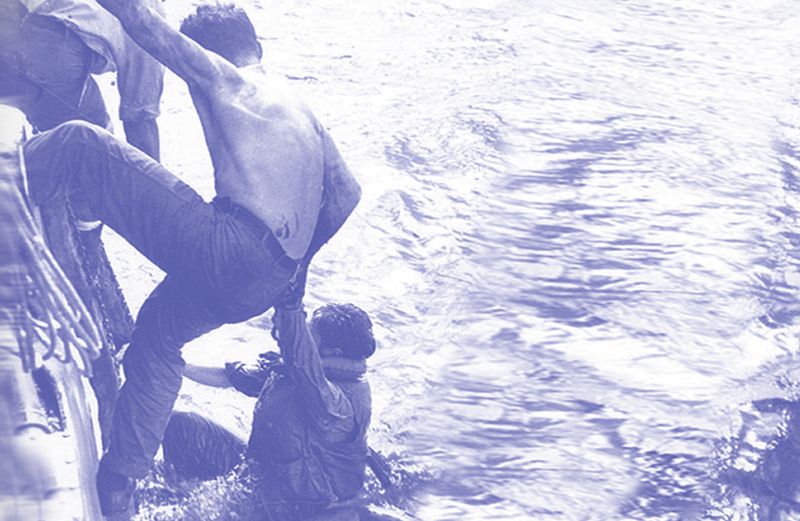The stories of countless heroes in war go untold. Until recently, Angela Davis of Huntington Beach, California, believed that her uncle was one of these lost figures, a hero unheralded by history.
Morris Seronick was 20 years old the morning of October 25, 1944. He was a seaman first class on the U.S.S. Hoel, anchored in the Leyte Gulf in the Philippines. A day earlier, the famed Fleet Admiral William “Bull” Halsey, Jr.’s battle group had engaged the main Japanese fleet, leaving the Imperial Navy in disarray.
Halsey and the bulk of his ships steamed northward to chase what he believed was the biggest remaining Japanese naval threat, leaving behind only the Hoel, two other destroyers and a small, lightly armed flotilla to protect the gulf and the soldiers on the island of Leyte, a major base of operations for the Allies’ Pacific campaign.
At 6:50 A.M., a U.S. patrol pilot radioed a warning. An armada of heavily armed ships—four supersized battleships, seven heavy cruisers and nine destroyers—was speeding at 30 knots toward the San Bernardino Straits, a critical passageway to the Philippines.
The Japanese had tricked Halsey—the ships to the north were a decoy! With no help coming, the Hoel, the U.S.S. Johnston, and half a dozen smaller ships raced to intercept the enemy fleet. The Americans were outgunned, little more than tin cans bobbing in the waves. But they fought gallantly.
Using smoke screens and loosing a barrage of 10 torpedoes, the Hoel held off the enemy for two hours, despite losing both engines, all but two guns and taking more than 40 direct hits. Three enemy ships were destroyed, and another crippled; eventually the Japanese were forced to change course.
At the end of the battle, however, both the Hoel and the Johnston were sunk. Of the 340 men aboard the Hoel, only 88 were pulled from the shark-infested waters alive. Morris Seronick was not among them.
History recorded that the fight helped the Allies win the Battle of Leyte Gulf, the largest naval engagement of World War II. But Angela’s mother, only 11 years old at the time, was haunted by the loss of her big brother. There was no record of when or how he had died.
In her dreams, she imagined he had washed up on a Pacific island with no memory, living out his days sipping coconut milk on the beach. But that was a fantasy. Angela’s mother died without knowing her brother’s fate. That lack of closure had always saddened her.
Angela knew almost nothing about the U.S.S. Hoel. Her husband, Jeff, was the history buff, not her. She had more urgent things on her mind. Jeff, himself a 20-year Navy veteran, had been laid off as an engineer for the Union Pacific railroad.
For months, he sat around the house, sinking into depression. That concerned Angela more than the loss of a paycheck. God, she finally begged, find him something to do. Anything.
Their daughter Mariah worked at the Huntington Beach library. “Dad, at least read a book,” she urged. Jeff’s love of history attracted him to stories about America’s greatest leaders. And his spirit lifted as he retold some of those stories to Angela.
The biography of William Halsey, Jr., mentioned a battle in the Philippines. Jeff dug deeper. He found an obscure book called The Last Stand of the Tin Can Sailors. He was riveted.
One night, Angela was sitting with her laptop when Jeff came racing into the room, waving a copy of the book. “I have something to show you,” he said.
He flipped to a page near the end, a list of the 252 men who had perished in battle on a ship called the U.S.S. Hoel. Jeff pointed near the top of the page.
“Uncle Morris!” Angela cried.
The book mentioned an association for the Hoel survivors. A man named Warren Stirling was listed as treasurer. Jeff and Angela immediately looked him up online. There was one match, an amazing match. He was in Huntington Beach. Only a few blocks away.
Angela called Stirling. He didn’t know Uncle Morris, but he told her that the surviving crew members held an annual reunion. “You should come,” he urged. “There aren’t many of the crew left.”
Seven Hoel survivors and many family members attended the event in San Diego a few months later—along with Angela and Jeff. “Did any of you know Morris Seronick?” they asked. One grizzled man spoke up. “I knew Morrie, as we called him. I was on his detail,” the old shipmate said.
His stories about Morris were as riveting as Jeff’s book had been. During the battle they were with a gun crew near the stern. The veteran’s eyes welled with tears at the memory. “A shell hit us. Your uncle died at his post, doing his duty, brave to the end.”
It seemed impossible that after so many years, there was still someone alive who was there with Morris that day, there with him when he died. Someone whose hand Angela could shake and who she could thank for helping her close a chapter of her family’s story.
Jeff found a good job—as an aircraft mechanic. But in the interim, he’d been given an important job to do. Unknowingly, he’d helped his wife uncover the fate of her mother’s beloved brother. The hero she had never met but now knew.
Download your FREE ebook, Mysterious Ways: 9 Inspiring Stories that Show Evidence of God’s Love and God’s Grace





